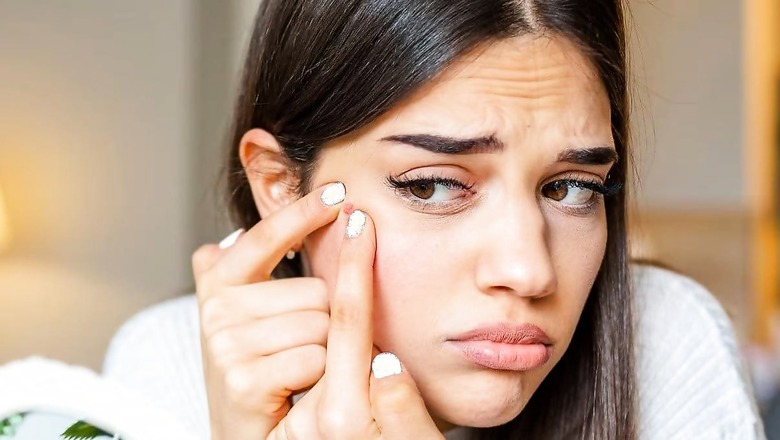
136
views
views
Here are 10 signs highlighting the importance of visiting your dermatologist after your 20s
In your 20s, regular dermatologist visits are crucial for maintaining healthy skin. Skin changes, lifestyle factors, and potential issues make these check-ups essential. Here are 10 signs highlighting the importance of visiting your dermatologist after your 20s by Dr Akanksha Sanghvi, Aesthetic Dermatologist, Founder, Oprava Aesthetics
- RosaceaRosacea is a skin condition that causes skin redness, flushing and bumps with frequent flare-ups that sometimes involve the eyes too. If you have been facing symptoms of rosacea you must visit a dermatologist for a skin treatment consisting of topical medications and laser or light treatments that can help control the symptoms. The symptoms of rosacea tend to flare up post 45 and it’s important to understand your triggers which commonly include spicy food, alcohol, hot beverages, stress, hormones, UV exposure and exercise. It’s important to get rosacea treated to avoid increased skin sensitivity, prominent vessels on the skin, and redness of conjunctiva including corneal damage and disfigurement of the nose.
- AcneAcne is a common problem not only affecting teenagers but also adults. It’s important to understand the cause of acne and seek appropriate treatment for the same to prevent aggravation and permanent scarring of the skin. Acne medications can range from topical applications to oral tablets that can help control future breakouts and treat existing acne lesions. A dermatologist can help form a suitable skin regime for you with the right products consisting of pan-balanced cleansers, AHA BHA exfoliating toners, niacinamide-based serums and some medicated applications. You might also opt for some in-clinic treatments such as glycolic and salicylic acid-based chemical peels, LED light therapy, and medicated cleanups for the same.
- WartsWarts are growths on your skin which look like a cluster of tiny rough bumps on the skin that are caused by Human papillomavirus (HPV). Warts tend to look like skin tags and harmless skin growths that can be easily ignored, however, they must be treated if they are sitting there for too long and not going away on their own. If you have new warts growing on your body or if you have symptomatic warts you must visit a dermatologist for appropriate treatment. Warts can also be treated for cosmetic concerns where they can be surgically cauterized (burning them superficially) for effective removal. Sometimes you may be prescribed topical medications to apply on the warts to exfoliate the cells containing the virus. You might be advised cryotherapy which means freezing the warts with a jet of liquid nitrogen that destroys the wart and the surrounding skin.
- Dermatitis & RashesDermatitis can affect the skin of any part of the body and can cause itching, stinging, burning, flaking and redness. Many causes of dermatitis can be due to allergy or some chemical or irritant substance you have come in contact with. Dermatitis can present as dry rough scaly patches that itch to wet oozing red patches that sting or burn. Your dermatologist can help soothe these symptoms using topical medications and emollients as well as help you identify your cause of dermatitis.
- Unusual, abnormal molesMoles are normally flat or raised, skin-coloured or pigmented growths on the skin. These are harmless and insignificant unless they start to change by appearing darker, bigger, or irregular or start bleeding, itching or oozing. Changing abnormal moles can be a sign of skin cancer. You must visit your dermatologist and they will assess your mole using a dermo scope and do a biopsy if suspicious. Though skin cancers are rare in people of Indian ethnicity, it’s still important to be aware of alarming signs of changing moles and get them evaluated whenever in doubt.
- Hair lossEveryone faces hair loss often in their lives. It’s important to get your hair loss evaluated for a cause, in case you’ve been facing hair loss for more than two months. Causes of hair loss can be multifactorial and can be due to changes in diet, lifestyle, hormonal issues, recent illness, surgery and certain medications. A visit to a dermatologist for your hair loss can help you identify the type of hair loss and can advise a suitable treatment to arrest the hair fall and promote new hair growth. The dermatologist will prescribe nutritional supplements, topical hair peptides or even minoxidil for hair growth depending on the type of hair loss. You can opt for treatments such as PRP (Platelet Rich Plasma) or (Growth factor Concentrate) GFC for treatment of more advanced long-term hair loss that has been not responding to any treatments.
- Premature AgingAging is an ongoing process. The appearance of fine lines, dull skin, pigmentation and loss of skin firmness is one of the first signs of ageing. You can seek a dermatologist’s help to address these early signs of ageing to delay or control your ageing process. Your dermatologist will help you form a regime that consists of multi-peptide, hyaluronic acid, retinol and moisturisers that can help hydrate and repair your skin by minimising fine lines and rough texture. You may be advised to go for radiofrequency skin tightening treatments and PRP (Platelet Rich Plasma) treatments for overall skin rejuvenation and improving collagen formation in the skin.
- HyperpigmentationPigmentary changes, discolouration, dull skin and age/ acne spots can be a major cosmetic concern and require assessment, treatment & maintenance. A dermatologist usually assesses the type and cause of pigmentation on the skin and treats it accordingly using topical creams or serums rich in vitamin C, kojic acid, glycolic acid or tranexamic acid. Detailed counselling on the importance of sunscreen can help you understand what sunscreen suits your skin type and how often to apply it. You can try treatments such as retinol peels, Q switch laser toning, mesotherapy for more intense treatment of hyperpigmentation and routine maintenance of your results.
- Nail disordersNails are commonly affected by psoriasis, thyroid disorders, eczema, nutritional deficiencies and many more serious internal infectious or inflammatory diseases. Nails can present with brittleness, discolouration, thickening or thinning, with lines or pits. A dermatologist can check your nails for some significant signs and can help identify the cause of nail changes which can be skin-related or something more serious. A dermatologist can also help you treat ingrown nails and nail fungal infections.
- ScarsScars are cosmetic concerns and are of many types ranging from acne scars to surgical scars. Acne scarring needs to be addressed by a dermatologist using treatments such as Erbium YAG laser, Micro needling RF (MNRF), Micro needling PRP and much more. Surgical scars can be depressed or raised such as hypertrophic scars or keloids all of which can be treated by a dermatologist. You may be advised above treatments for the same or suggested a scar revision treatment depending on the size and area of your scar.




















Comments
0 comment